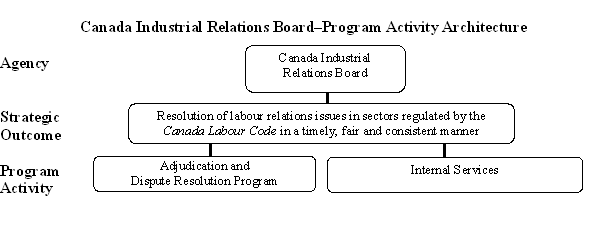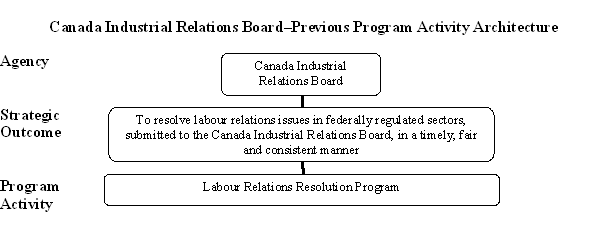Common menu bar links
Breadcrumb Trail
ARCHIVED - Canada Industrial Relations Board
 This page has been archived.
This page has been archived.
Archived Content
Information identified as archived on the Web is for reference, research or recordkeeping purposes. It has not been altered or updated after the date of archiving. Web pages that are archived on the Web are not subject to the Government of Canada Web Standards. As per the Communications Policy of the Government of Canada, you can request alternate formats on the "Contact Us" page.
SECTION I–OVERVIEW
1.1 Message from the Chairperson
 As the Chairperson of the Canada Industrial Relations Board (CIRB or the Board), I am pleased to present to Parliament and to Canadians its 2009–10 Report on Plans and Priorities. The Board was established in January 1999, to replace the previous Canada
Labour Relations Board (CLRB), and is an independent, representational, quasi-judicial tribunal responsible for the interpretation and application of the Canada Labour Code (the Code) Part I, Industrial Relations, and certain provisions of Part II, Occupational Health and Safety.
As the Chairperson of the Canada Industrial Relations Board (CIRB or the Board), I am pleased to present to Parliament and to Canadians its 2009–10 Report on Plans and Priorities. The Board was established in January 1999, to replace the previous Canada
Labour Relations Board (CLRB), and is an independent, representational, quasi-judicial tribunal responsible for the interpretation and application of the Canada Labour Code (the Code) Part I, Industrial Relations, and certain provisions of Part II, Occupational Health and Safety.
Since my appointment as the Chairperson of the CIRB a little over a year ago, it has been my commitment to ensure that the Board achieves its statutory mandate, while at the same time finding means of significantly reducing the number of outstanding cases, and providing parties with a resolution of issues on a more timely basis.
The number of applications/complaints received by the Board in 2008–09 was below average, and given the state of the economic climate, it is difficult to predict at this time what the volume may be in 2009–10. With respect to the resolution of matters, the Board expects to increase its disposition of cases by more than 160 in 2008–09 compared to the previous two fiscal years. As a result, the number of backlog cases is expected to drop to 370 as of March 31, 2009, the lowest level since 1985–86.
The Board’s main operational priorities for 2009–10 will be to continue its efforts to reduce the number of pending matters and decrease the time the Board takes to process a case from start to finish. The CIRB must also focus on continuously improving its management practices. Accordingly, the Board will devote efforts to respond to the results of the Management Accountability Framework evaluation, which will become available at the beginning of the fiscal year.
I am proud of the progress we have made since my appointment last year, and I look forward to leading the CIRB in the achievement of its goals in 2009–10. I am confident that the Board’s members and staff will maintain their efforts in the year ahead in order to ensure that the Board remains responsive to the needs of the labour management community.
Elizabeth E. MacPherson
Chairperson
1.2 Summary Information
1.2.1 Raison d’être and Responsibilities
Raison d’être–The mandate of the Canada Industrial Relations Board is to contribute to and promote a harmonious industrial relations climate in the federally regulated sectors through the impartial, effective and appropriate administration of the rules of conduct that govern labour and management in their representational and bargaining activities. In achieving this mandate, the Board provides effective industrial relations solutions for the Canadian labour relations community in a fair and timely manner.
The Canada Industrial Relations Board is an independent, representational, quasi-judicial tribunal responsible for the interpretation and application of the Canada Labour Code, Part I, Industrial Relations, and certain provisions of Part II, Occupational Health and Safety. It was established in January 1999, to replace the previous Canada Labour Relations Board, through amendments to Part I of the Code.
The adjudicative team of the Board is currently composed of the Chairperson, four full-time and one part-time Vice-Chairpersons, and six full-time members—all of whom are Governor-in-Council appointees. The Code requires that the Chairperson and Vice-Chairpersons must have experience and expertise in industrial relations, and that members are to be appointed after consultation with the organizations representative of employees or employers.
The CIRB has jurisdiction in all provinces and territories with respect to federal works, undertakings or businesses in the following sectors:
- Broadcasting
- Chartered banks
- Postal services
- Airports and air transportation
- Shipping and navigation
- Inter-provincial or international transportation by road, railway, ferry or pipeline
- Telecommunications
- Grain handling and uranium mining and processing
- Most public and private sector activities in the Yukon, Nunavut and the Northwest Territories
- Band Councils and some First Nations undertakings
- Certain Crown corporations (including, among others, Atomic Energy of Canada Limited and the national museums)
This jurisdiction covers some 850,000 employees and their employers, and includes enterprises that have an enormous economic, social, and cultural impact on Canadians from coast to coast. The variety of activities conducted by the federally regulated sector, as well as its geographical spread and national significance, contribute to the uniqueness of the federal jurisdiction and the role of the CIRB, and pose particular challenges for the Board’s work.
The Board has established a series of strategic objectives in support of its mandate, which include to:
- seek solutions to labour relations problems by determining the cause and nature of conflict and by applying the appropriate dispute resolution mechanism, including fact finding, mediation and adjudication;
- conduct its activities in a fair, timely and consistent manner;
- consult its clients on its performance and on the development of policies and practices;
- promote an understanding of its role, processes and jurisprudence through client contact and a variety of information dissemination methods;
- conduct its business and manage its resources in a manner that is fiscally sound, in accordance with the Financial Administration Act and the policies and directives of the central agencies of government.
1.2.2 Strategic Outcome and Program Activity Architecture
In pursuing its mandate, the CIRB is guided by its strategic outcome (SO), which is the resolution of labour relations issues in sectors regulated by the Canada Labour Code in a timely, fair and consistent manner. The SO is the long-term benefit for Canadians that the CIRB aims to achieve. Associated with the SO is one operational program activity (PA), which is the Adjudication and Dispute Resolution Program and Internal Services. This is shown graphically in the CIRB’s Program Activity Architecture (PAA) below.
Canada Industrial Relations Board–Program Activity Architecture

1.2.2.1 PAA Crosswalk
It should be noted that the above PAA is new for 2009–10, as the CIRB recently made modifications to the wording of both its strategic outcome and program activity, in consultation with the Treasury Board. The modifications are only meant to better describe the CIRB’s strategic outcome and program activity and do not reflect any underlying changes to them. The new PAA also separates out internal services. The previous PAA is provided below for comparison.
Canada Industrial Relations Board–Previous Program Activity Architecture

1.3 Planning Summary
1.3.1 Financial and Human Resources
The financial resources table below provides a summary of the total planned spending for the Canada Industrial Relations Board for the next three fiscal years, whereas the following table shows a summary of the total planned human resources for the CIRB over the same period.
| 2009–10 | 2010–11 | 2011–12 |
|---|---|---|
| 12,587 | 12,587 | 12,587 |
| 2009–10 | 2010–11 | 2011–12 |
|---|---|---|
| 110 | 110 | 110 |
Summary Table
| Performance Indicators | Targets |
|---|---|
| Number of applications/complaints resolved as a percentage of applications/complaints received | 100% |
| Program Activity | Forecast Spending ($ thousands) 2008–09 |
Planned Spending ($ thousands) |
Alignment to Government of Canada Outcomes | ||
|---|---|---|---|---|---|
| 2009–10 | 2010–11 | 2011–12 | |||
| Adjudicative and Dispute Resolution Program | 13,549 | 9,188 | 9,188 | 9,188 | Income security and employment for Canadians |
| Internal Services | All FY 2008–09 spending was reported under the Adjudicative and Dispute Resolution Program activity. The requirement to report on Internal Services is new for FY 2009–10 | 3,399 | 3,399 | 3,399 | |
| Total Planned Spending | 12,587 | 12,587 | 12,587 | ||
1.3.2 Priorities and their Contribution to the Strategic Outcome
Agency Priorities1 and their Contribution to the Strategic Outcome
| Operational Priorities | Type | Description |
|---|---|---|
| Deliver on the Board’s statutory mandate under the Canada Labour Code | Ongoing | This involves delivering the services the CIRB is mandated to provide by the Canada Labour Code |
| Maintain accelerated reduction of the number of backlog cases | Ongoing | Continue to reduce the number of pending matters that have accumulated over previous years |
| Reduce average case disposition time | Ongoing | To reduce the average time it takes the CIRB to process matters and provide a decision |
| Monitoring and fine-tuning of new duty of fair representation complaint process and disposition | Ongoing | To continue to improve on the Board’s work to simplify and accelerate the processing of duty of fair representation complaints. This measure contributes to the previous two priorities. |
| Continue Client consultations | Ongoing | The CIRB’s Client Consultation Committee is the Board’s link to its stakeholder community. It provides the Board with advice to address client concerns. |
| Management Priorities | Type | Description |
|---|---|---|
| Prepare action plan following the Board’s Management Accountability Framework Evaluation | New | The Management Accountability Framework evaluates an organization’s management practices for various items such as finances, human resources, etc. Evaluation results, which are due in the spring of 2009, will be reviewed and an action plan for corrective measures, if required, will be developed and acted upon. |
1 Since the Canada Industrial Relations Board only has one strategic outcome, all Board priorities relate to the same outcoume.
1.3.3 Risk Analysis
The CIRB is a low risk agency. Financially, approximately four fifths (80%) of its $12.5 million operating budget is for salaries and benefits. Of the remaining $2.5 million in Operations and Maintenance (O&M), 60% is for travel and professional services, and is largely related to the processing of cases such as travel to external hearings, temporary rental of hearing rooms, interpretation services and translation of Board decisions. The Board adheres to Treasury Board policies for the expenditure of its O&M budget.
As a result of the low risk nature and small size of the CIRB, the risk management process is not overly complex. Risk is evaluated and mitigated within the regular operational activities or projects. The Board’s largest operational risk is associated with its backlog of cases, in that a given situation may deteriorate before the Board can deal with it. To mitigate this risk, priority is given to the processing and consideration of matters in which it appears that delay will pose a significant potential for industrial relations problems, or where other identifiable factors require a matter to be promptly addressed. Furthermore, over the last year, the CIRB adopted new procedures for the treatment of duty of fair representation complaints, and fine-tuned the processing of applications for certification, which represent more than 40% of the Board’s yearly incoming volume, as well as backlog cases. It is expected that the new procedures will greatly reduce the time it takes to process these types of matters, which in turn will reduce the number of backlog cases.
In addition to the timeliness of decisions, a second operational risk involves the quality of the decisions. Poor decisions, or decisions that are not based on sound legal and industrial relations principles, would not only lead to flawed jurisprudence, but would also create uncertainty in the client community. It should be noted that all but one judicial review application to the Federal Court of Appeal have been dismissed in the 2003–04 to 2007–08 period. This underscores the importance of the quality of Governor-in-Council appointments that are made to the Board and the experience and expertise that these appointees bring to it.
On the human resources front, the CIRB, like most of the federal public service, is facing challenges such as employee retention and staffing of positions vacated by departures due to retirement. Also, like other small agencies, the CIRB has identified issues related to career progression within the agency. These and other concerns are being addressed in the CIRB’s Human Resources Strategic Plan.
The CIRB’s risk profile and mitigation plan is adjusted periodically, usually following its annual retreat, after discussion of the Board’s current situation and future directions.
1.3.4 Expenditure Profile
There has been no significant deviation in the expenditure trend of the CIRB over the past years. However for the 2008–09 fiscal year, the forecast spending is expected to increase by 8% over the previous year, an increase that can be attributed to the relocation of the Board’s regional offices in Montréal and Vancouver as a result of Public Works and Government Services Canada initiatives.

1.3.4.1 Voted and Statutory Items
| Voted or Statutory Item ($ thousands) | Truncated Vote or Statutory Wording | 2008–09 Main Estimates |
2009–10 Main Estimates |
|---|---|---|---|
| 10 | Operating expenditures | 11,018 | 11,122 |
| (S) | Contributions to employee benefit plans | 1,490 | 1,465 |
| Total Agency | 12,508 | 12,587 | |
